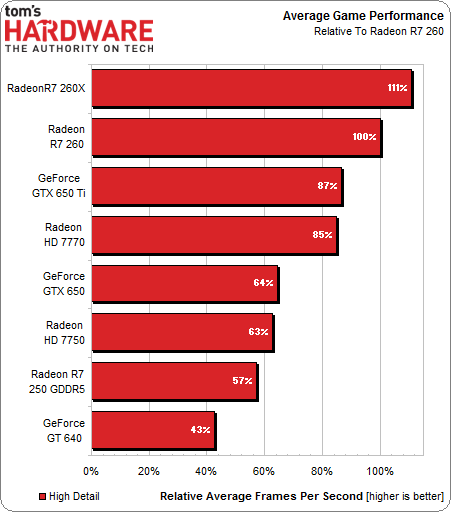AMD Radeon R7 260 Review: The Bonaire GPU Rides Again
AMD announced its Radeon R7 260 in December of last year, and we were excited about a $110 Radeon HD 7770 replacement. Almost two months later, one model is available on Newegg for $140. Today, we're testing the card and pondering its curious position.
The Radeon R7 260's Unrealized Potential
Nothing puts our benchmarks into perspective like a chart of average performance. Right out of the gate, let's look at the aggregate results of the seven other cards we tested relative to AMD's new Radeon R7 260:
Put simply, the Radeon HD 7770 is about 15% slower than the new Radeon R7 260, and the 260X is about 11% faster. Those numbers don't sound like much, but the HD 7770 dropped as low as 33 FPS in some benchmarks, while the R7 260 never fell below 40. Particularly at 1920x1080, that's a significant margin. On the other hand, AMD's Radeon R7 260X performs better, but not so much that it facilitates higher resolutions. It might allow for a couple of more taxing details without dropping below 30 FPS. However, the two cards come pretty close to each other.
If I was writing this review last month, when the Radeon R7 260 paper-launched at $110, I would have drizzled praise all over it for making the Radeon HD 7770 obsolete. The Radeon R7 260X at $140 and R7 260 at $110 appear a formidable pair, indeed.
But one month later, the Radeon R7 260 is largely missing in action aside from a token entry selling for $140 (Ed.: And now a second model at $125, which we still consider too close to the 260X, found as low as $130). We're scratching our heads. The product we're reviewing is as expensive as competing Radeon R7 260X cards with two times more memory. Thirty dollars might not sound like much, but in the competitive space under $150, it's the difference between an exceptional deal and outright poor value. Perfect example: spending $10 more gets you Asus' R7260X-DC2OC-2GD5, which not only includes a faster GPU, but also twice as much on-board RAM.
An AMD representative we talked to ahead of this piece stated that the company samples hardware to its partners, which then decide what they want to sell. At least for now, it seems as though the add-in board folks are happy with the relationship between the Radeon HD 7770 at $110 and R7 260X at $140.
Here's a bit of perspective. With the GeForce GTX 650 Ti Boost missing, the Radeon R7 260X rules at its price point. And the GeForce GTX 650 Ti is a little overpriced against AMD's Radeon HD 7770. I can't imagine there's a lot of incentive to create another space between those two successful products.
Regardless, it appears that the Radeon R7 260 isn't emerging as the value-oriented product we were anticipating, at least in the near future. That could, of course, change over time (and potentially quite quickly if Nvidia strikes with competitive-priced competition for the Radeon HD 7770). Until then, the Radeon R7 260 is too rare and too expensive to recommend over other, more compelling options in the same space.
Get Tom's Hardware's best news and in-depth reviews, straight to your inbox.
Current page: The Radeon R7 260's Unrealized Potential
Prev Page Power And Temperature BenchmarksDon Woligroski was a former senior hardware editor for Tom's Hardware. He has covered a wide range of PC hardware topics, including CPUs, GPUs, system building, and emerging technologies.
-
Novuake Mildly frustrating the HD 7790 is not included. Since its bonaire too? You know, the apples with apples concept?:/Reply -
mapesdhs If the price difference is so small compared to the 260X, why would anyoneReply
bother with the 260? Skip a couple of beers and get a 260X. An utterly
unnecessary product IMO, it's just making use of dies that couldn't make the
grade for higher models.
Also, it's sad that we don't see single-slot cards anymore.
Ian.
-
rdc85 I'm agreed with the review,I think in their perspective the 7770 still selling well, there no rush to put 260 out...putting it out at 110~120 will cannibalize the 7770...Reply -
wtfxxxgp Hmmm... I don't really know where I stand on this one. I suppose I want to see what happens when the market forces of supply and demand start having an effect on the price, otherwise, I think it's a pretty decent card but just TOO close to the 260X which may be the one I'd choose if I were looking for a card in that league. I'm getting my GTX 760 at month-end finally, so this is not going to turn my head or change my plans...Reply -
ddpruitt Great review, especially given what it's competing at in the same price range. It's interesting that AMD isn't pushing vendors to differentiate the products a bit more and get rid of the 7770s to allow more room for the R260s to breath. However...Reply
Naturally, discrete graphics cards require a substantial amount of stable power, so XFX sent along its PRO850W 80 PLUS Bronze-certified power supply. This modular PSU employs a single +12 V rail rated for 70 A. XFX claims that this unit provides 850 W of continuous power
Statements like this are what's causing Watt inflation and the myth that you need a dedicated transformer to run a PC. The review itself points out that system wattage is less than a quarter of the max continuous wattage. I think it's a serious disservice to constantly repeat this statement when it's clearly not true. At the very least it should be rewritten a bit. -
vertexx Reply12618389 said:Also, it's sad that we don't see single-slot cards anymore.
I agree - that would be one way AMD could differentiate with some of these models is to have one or two designed to be single-slot and/or low profile. That would add some reason for this insanity.
